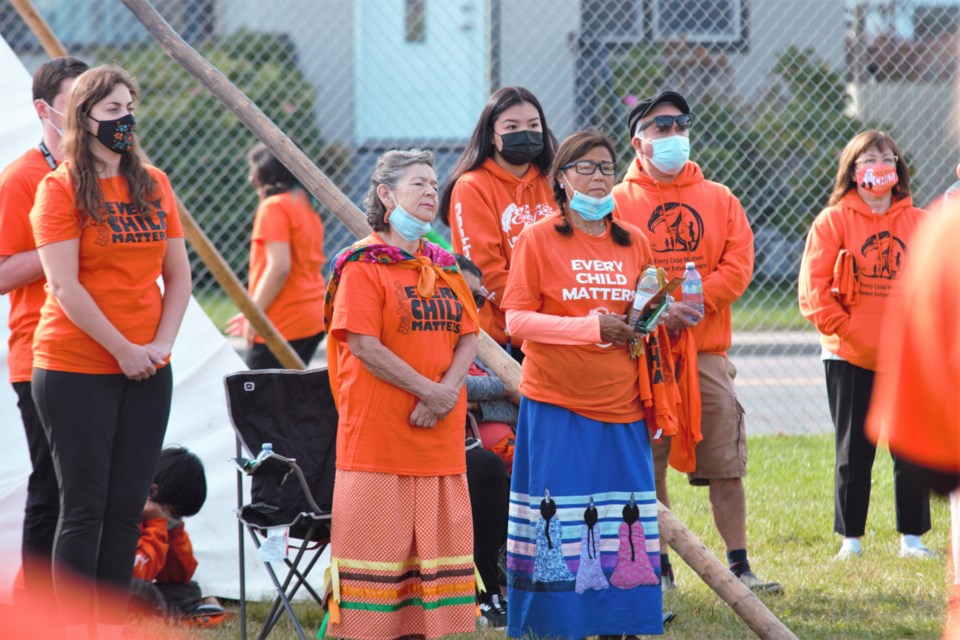THUNDER BAY – Hundreds of people gathered Thursday as Nishnawbe Aski Nation recognized the first National Day for Truth and Reconciliation, hearing the words of residential school survivors on the site where one of those institutions once stood.
Survivors and leaders expressed tentative hope that the official recognition of Sept. 30 would help spur greater understanding of Canada’s history of residential schools, and healing for Indigenous communities.
The event, held at Pope John Paul II school in Thunder Bay’s south end, saw numerous political leaders, residential school survivors, and Indigenous youth speak. NAN also hosted a sacred fire on the site, and offered informational displays, and activities for children.
A moment of silence was observed to honour residential school victims and survivors, while MC Anne Magiskan also recognized lives lost more recently to suicide and overdoses.
NAN Deputy Grand Chief Anna Betty Achneepineskum said the federal government’s move earlier this year to declare the day as a statutory holiday was a positive step, after the date was informally recognized as Orange Shirt Day for years.
She said the growing recognition of the abuses committed in the institutions, and the lasting impacts on First Nations, can be a powerful unburdening for some survivors.
“It’s encouraging through the years that we come to these gatherings, that heaviness has gotten lighter,” she said. “I’ve heard comments from [survivors] saying, finally we’re getting the recognition and acknowledgement.
“Many used to gather and they had very little support. It’s encouraging more people are coming out and wanting to learn. That’s one of the benefits of having this day as a holiday – people will ask those questions and have those discussions.”
Health Minister Patty Hajdu said the new holiday is an occasion for Canadians to grapple with the country’s history, and their personal role in reconciliation.
“Take a look at all these children here today,” she urged the crowd. “We’re not just doing this for us… We’re doing this so the legacy doesn’t continue for those who follow.”
Elder Sam Achneepineskum, who attended three residential schools in Northwestern Ontario, in the 1960s and 1970s, shared some of his experiences with attendees Thursday.
It can be uncomfortable hearing the stories of survivors, he said, but he considers it essential.
“A whole generation of our people went,” he said. “It’s a very important part of the history of Canada. I hope they teach that in school, and they never stop talking about it.”
He’s seen a real shift in understanding among non-Indigenous Canadians since the Truth and Reconciliation Commission delivered its final report in 2015.
While he’s encouraged by that, he said learning the truth must be followed by real action from leaders and non-Indigenous Canadians. He singled out the Catholic Church as an institution that has yet to meaningfully address its role in running many of the schools.
“We hear that word, reconciliation, a lot,” he said. “There has to be substance to it.”
Terri Fiddler spoke to the crowd about the lifelong marks left by the institutions for many survivor, sharing how it profoundly shaped the parenting experience of her late husband, Josias Fiddler, who was a NAN elder.He experienced serious abuse in residential school, Fiddler said.
“He carried that after he left residential school," she said. "Like many others, it affected the way he carried his family life. In residential school, you don’t get hugs, you don’t get goodnight stories."
He struggled to take part in celebrations like birthday parties until later in his life, she said.
“He didn’t know how to celebrate, because in residential schools you don’t celebrate. Your birthdays go unnoticed.”
Chief Peter Collins of Fort William First Nation lauded the municipal and federal governments for taking steps in the right direction, pointing to the city’s National Day for Truth and Reconciliation event earlier in the day, and the Trudeau government’s move toward implementing the United Nations Declaration on the Rights of Indigenous Peoples (UNDRIP).
However, he said much more work remained. That will include an investigation of the grounds of the Pope John Paul II school where Thursday’s event was held, he said.
The school sits on the former site of the St. Joseph’s Indian Residential School, which was affiliated with the Catholic Church and operated from 1870 to 1966, first as a girls orphanage and later as a residential school.
NAN is developing a process to support survivors and families in investigating former school sites, said Anna Betty Achneepineskum.
It has convened a group of survivors who will serve as advisors on the process, and held an initial meeting.
“Whatever process we develop, it has to be survivor-led,” she said.
